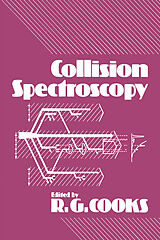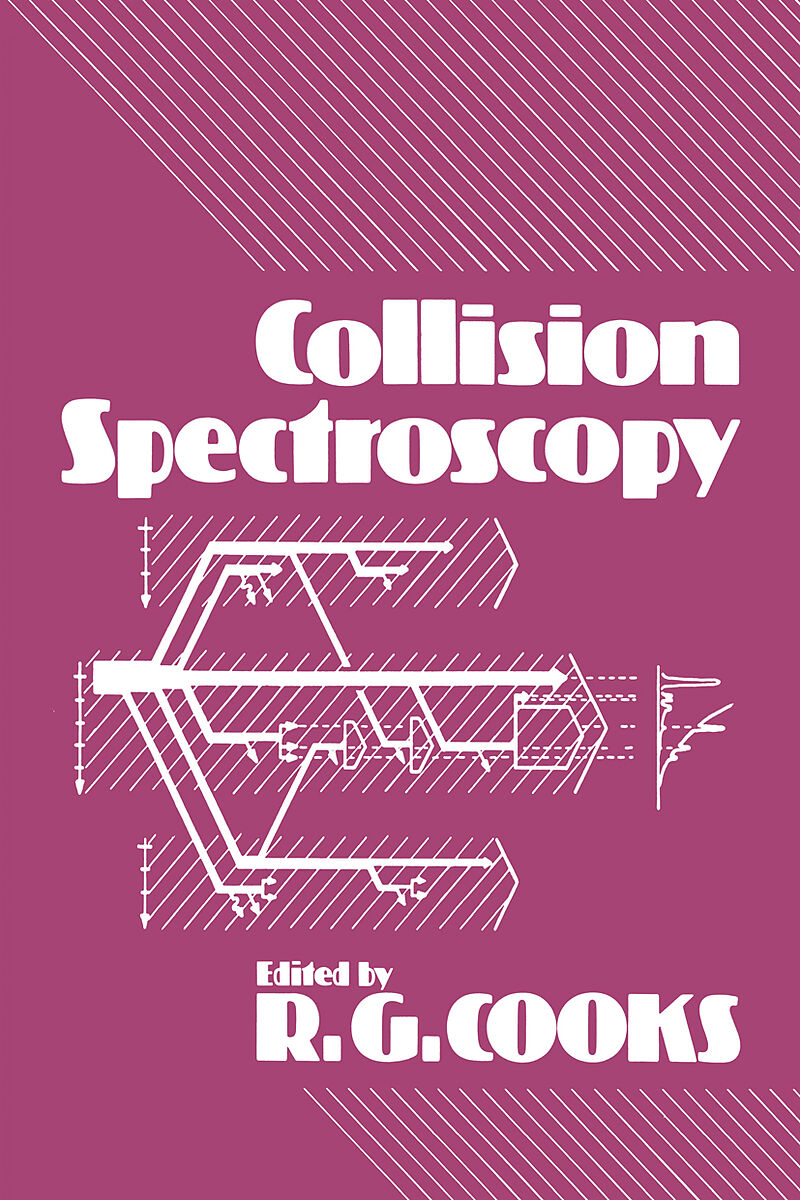Collision Spectroscopy
Format:
E-Book (pdf)
EAN:
9781461339557
Genre:
Chemie
Herausgeber:
Springer New York
Anzahl Seiten:
458
Erscheinungsdatum:
06.12.2012
R. G. Cooks This introduction has three purposes: (a) to summarize some of the chief features of energy spectrometry of ions and to sketch in a little of the background to this subject, (b) to present some simple facts about collision processes which one skilled in, say, mass spectrometry but innocent of any knowledge of bimolecular collisions might find of value, and (c) to indicate the scope and content of the volume. 1. The Subject This book takes as its subject, ion-molecule and ion-atom reactions occurring at high energies. It emphasizes the study of inelastic reactions at high energy through measurements of translational energy. The investiga tion of these reactions using other procedures has been important in the cases of the simpler systems. In particular, the emitted radiation has been investigated and this subject is therefore discussed where appropriate. For more complex species, however, there is little information available other than from energy spectra. The defining characteristic of the energy range of interest is that momentum transfer to the neutral target is negligible for small scattering angles. The result of this apparently bland condition is a welcome simplicity in the interpretation of the results of what appears to be developing into a R. G. Cooks . Department of Chemistry, Purdue University, West Lafayette, Indiana 47907. 2 Introduction unique form of spectroscopy. The names ion kinetic-energy spectrometry, translational energy spectrometry, collision spectroscopy, and energy-loss spectrometry have all been used to describe this subject (d. Section 5).
Inhalt
1. The Subject.- 2. Metastable Ions.- 3. Types of Collisions.- 4. Collision Cross Sections.- 5. Energy Interconversions.- 6. Energy Resolution and Angular Resolution.- 7. Laboratory and Center-of-Mass Coordinate Systems.- 8. Guideposts to the Contents.- References.- 1 Collisional Excitation of Simple Systems.- 1. Introduction.- 1.1 Types of Collisions.- 1.2. Elements of Collision Theory.- 1.3. Experimental Methods.- 2. Determination of Excitation Cross Sections from Ion Energy- Loss Spectrometry.- 2.1. Apparatus.- 2.2. Analysis of the Energy-Loss Spectrometric Method.- 3. Determination of Excitation Cross Sections from Photon Emission Data.- 3.1. Incident Particle Flux Determination.- 3.2. Target Density Determination.- 3.3. Photon Flux Determination.- 4. The Excitation of Atomic Hydrogen.- 4.1. Modulated Crossed-Beam Technique.- 4.2. Energy-Loss Spectra of Atomic Hydrogen.- 5. Excitation of Helium.- 5.1. Energy-Loss Spectra of Helium.- 5.2. Optical Studies of the Excitation of Helium.- 6. Differential Cross-Section Measurements.- 7. Excitation of Simple Molecules.- 7.1. Excitation of Molecular Hydrogen.- 7.2. Excitation of Molecular Nitrogen.- 7.3. Excitation of Molecular Oxygen.- 7.4. Excitation of Singlet-Triplet Transitions.- 8. Discussion.- References.- 2 Charge Transfer in Atomic Systems.- 1. Introduction.- 2. Theory.- 2.1. Introduction.- 2.2. Semiclassical Cross Sections Differential in Angle and Energy.- 2.3. Transition Probabilities and Energy-Loss Spectra.- 2.4. General Considerations.- 3. Experimental Methods.- 3.1. Introduction.- 3.2. Pressure Measurement.- 3.3. Detectors.- 3.4. Beam Production.- 3.5. Cross-Section Measurements.- 4. Experimental Data and Interpretation.- 4.1. Introduction.- 4.2. Integrated Cross Sections.- 4.3. Energy-Loss Spectra with Doubly Charged Ions.- 4.4. Angular Differential Cross Sections.- 4.5. Cross Sections Differential in Angle and Energy.- 5. Summary.- References.- 3 Inelastic Energy Loss: Newer Experimental Techniques and Molecular Orbital Theory.- 1. Introduction.- 2. The Molecular Orbital Model.- 2.1. Molecular Orbitals for Collision Processes.- 2.2. Transitions between Molecular Orbitals.- 3. Experimental Techniques and Results.- 3.1. Energy-Loss Measurements.- 3.1.1. A Typical Scattered-Particle Apparatus.- 3.1.2. Time-of-Flight Measurements.- 3.1.3. The Use of Molecular Targets.- 3.1.4. Inner-Shell Excitations.- 3.2. Ion-Photon and Ion-Electron Coincidence Measurements.- 3.2.1 Introduction.- 3.2.2. Experimental Principles.- 3.2.3. Charge-Exchange Measurements Using Coincidence Techniques.- 3.2.4. Stueckelberg Oscillations.- 3.2.5. Rosenthal Oscillations and Long-Range Couplings.- 3.2.6. Polarization and Angular Distribution Measurements in Coincidence.- 3.2.7. Ion-Molecule Coincidence Measurements.- 4. Summary and Conclusion.- References.- 4 Double Electron Transfer and Related Reactions.- 1. Introduction.- 2. Cross Sections.- 3. Experimental Techniques of Double-Charge-Transfer Spectroscopy.- 3.1. The Instrument.- 3.2. The Energy-Loss Scale.- 3.3. An Apparatus with Higher Energy Resolution.- 3.4. Target Pressure Dependences of the Negative Ion Intensities.- 4. (H+, M) Spectra and the Study of the States of the Target Species.- 4.1. The Spin Conservation Rule.- 4.2. The Applicability of the Franck-Condon Principle.- 4.3. Selection Rules for the Symmetry of the Molecular States.- 4.4. Observation of Double-Charge-Transfer Processes at Different Scattering Angles.- 4.5. Determination of the Double-Ionization Potentials of Some Molecules.- 4.6. Observation of Radiative Transitions without Detection of thePhoton.- 5. (A+, Ar) Spectra: An Insight into Future Possible Developments.- 5.1. Determination of the State Composition of the A+Bearn.- 5.2. Determination of the Geometric Structure of a Polyatomic A+orA-Ion.- 5.3. The Electron Affinity of the Projectile Species A.- 5.4. Dissociative Double-Charge-Transfer Spectra.- Appendix: Energy Loss of the Projectile in an Inelastic Collision.- References.- 5 Ionic Collisions as the Basis for New Types of Mass Spectra.- 1. Introduction.- 2. 2E Mass Spectra.- 3. -E Mass Spectra.- 4. E/2 Mass Spectra.- 5. +E Mass Spectra.- 6. Other Types of Spectra.- References.- 6 Collision-Induced Dissociation of Diatomic Ions.- 1. Introduction.- 2. Dynamics of Dissociation.- 2.1. The Two-Step Model.- 2.2. Electronic Excitation.- 2.3. Vibrational/Rotational Dissociation.- 2.4. Predissociation.- 3. Experimental Techniques.- 3.1. The Aston Band Method.- 3.2. Initial-State Preparation.- 3.3. Final-State Analysis.- 3.4. The Apparatus Function.- 4. Direct Dissociation in Heavy-Particle Collisions.- 4.1. The Dissociation of H+2.- 4.2. The Dissociation of HeH+.- 4.3. Discussion.- 5. Translational Spectroscopy.- 5.1. Collisional Dissociation of 4-10 keV N+2 Ions.- 5.2. Collisional and Unimolecular Dissociation of 10-keV HeH+ Ions.- 5.3. Photodissociation of H+2.- 6. Concluding Remarks.- References.- 7 Collision-Induced Dissociation of Polyatomic Ions.- 1. Introduction.- 1.1. Scope of Chapter.- 1.2. Comparison with Metastable Ions.- 1.3. Development of CID Studies.- 2. The Reaction.- 2.1. The Basic Phenomenon and Its Experimental Characterization.- 2.2. Mechanism.- 2.3. Cross Section.- 2.4. Effects of Experimental Variables.- 3. Experimental Procedures.- 3.1. Instrumentation and Scanning Methods.- 3.2. Energy Resolution and Kinetic Energy Measurement.- 3.3. Other Considerations.- 4. Applications.- 4.1. Ion Structure Determination.- 4.2. Thermochemical Determinations.- 4.3. Fragmentation Mechanisms.- 4.4. Molecular Structure Determination.- 4.5. Analysis of Mixtures and Isotope Incorporation.- 4.6. Product Characterization in Ion-Molecule Reactions and Other Applications.- 5. Related Reactions.- 5.1. Negative Ions.- 5.2. Dissociative Charge Transfer.- 5.3. Related Ion-Surf ace Reactions.- 5.4. Related Photodissociations.- 5.5. CID Studied by Ion-Cyclotron Resonance Spectrometry.- 5.6. CID of Neutral Molecules.- 6. Prospects.- References.

Leider konnten wir für diesen Artikel keine Preise ermitteln ...
billigbuch.ch sucht jetzt für Sie die besten Angebote ...
Die aktuellen Verkaufspreise von 3 Onlineshops werden in Realtime abgefragt.
Sie können das gewünschte Produkt anschliessend direkt beim Anbieter Ihrer Wahl bestellen.
Loading...
Die aktuellen Verkaufspreise von 3 Onlineshops werden in Realtime abgefragt.
Sie können das gewünschte Produkt anschliessend direkt beim Anbieter Ihrer Wahl bestellen.
| # | Onlineshop | Preis CHF | Versand CHF | Total CHF | ||
|---|---|---|---|---|---|---|
| 1 | Seller | 0.00 | 0.00 | 0.00 |
